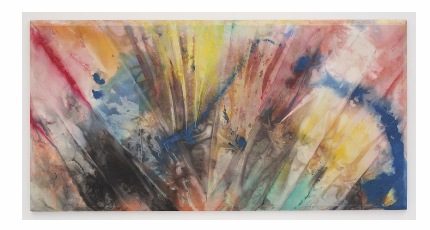Sam Gilliam
A bevel is also a facet. Gilliam faceted his canvases. Folding the fabric, the paint concertinas in upon itself, revealing, when opened, lines and planes of colour. Ray V (1970) has a bevelled edge, by which the painting becomes dimensional, cut from the wall. A stone can be faceted. So too, can a jewel. Facets, when carefully cut, create windows of light.
b.1933, Tupelo; d.2022, Washington, D.C.
“You can hear when you’re supposed to see and see what you’re not supposed to... What does it mean to draw an art form out of lovely, deadly social information?” Fred Moten wrote about Sam Gilliam in 2020. Moten intended his approach to be “more mimetic than analytic.” Black women hang up laundry, spied through an open window. Gilliam folds the canvas upon the wet paint on its surface. Fabric is cared for, and to this labour – the labour of black women having been rendered invisible, erased – is restored the title of ‘work’. The images world-build, repair. Any suggestion that Gilliam’s abstractions were unconcerned with black life and struggle are undone as life rises up from the canvas. The viewer is permitted to fall for the paintings, as Moten fell for Gilliam’s work, reverent, roaming their colours and creases. Examining Bruce Nauman’s John Coltrane Piece (1968), Mark Godfrey finds that, while white Abstract Expressionists referenced the experiments of Coltrane, the outcomes remained “anecdotally related”, whereas Gilliam’s use of colour and draping are, themselves, a form of cascade. Godfrey motivates for a true, formal affinity between black Abstract Expressionism and free jazz. This cascade, “folding it into music, letting it hang into performance” – Fred Moten, again – is Gilliam’s innovation in paint on the theme of Ornette Coleman’s compositions. When asked by Christian Lund in 2018 how abstract art could be political, Gilliam responded: “It messes with you. It convinces you that what you think, isn’t all… Just because it looks like something that resembles you doesn’t mean that you have understanding.” An anecdote by way of explanation: Godrey writes about Mary Campbell Smith describing how Gilliam came to paint the assassination of Martin Luther King. Something occurred on the canvas when Gilliam chose to fold and then unfold it. The material alchemy brought forth the subject of the work. Gilliam said “I just did free painting,” talking about his starts as a student, painting on plywood. Sam Gilliam committed his life to freedom, painting his own way.
